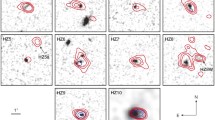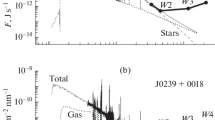Abstract
In 1983 the Infrared Astronomical Satellite (IRAS) surveyed the sky in four wavebands in the far infrared (FIR). One of the products of this survey1 is a detailed picture with an angular resolution of ∼4 arc min of the infrared emission of the interstellar dust in the galactic plane. Here we point out the remarkably detailed correlation between the 60-µm band emission and most of the features in the 11-cm radio-continuum emission as measured by Reich et al.2 with a beam width of 4.3 arc min. This correlation has two consequences. First, it gives support to the model of Cox et al.3 in which the 60-µm band emission arises mainly from dust associated with extended low-density (ELD) H II regions. Second, it provides a way of separating the thermal component of the radio continuum, identified by its associated infrared emission, from the synchrotron component. When the infrared and radio maps are compared, the known supernova remnants stand out boldly as radio sources which do not have the corresponding infrared emission. Candidates for hitherto undiscovered supernova remnants can be found by looking for additional radio sources lacking infrared emission. Larger-scale structure of the galactic magnetic field near the galactic plane will be revealed after the synchrotron emission, uncontaminated by thermal emission, has been obtained in this way.
Similar content being viewed by others
References
1. IRAS Explanatory Supplement (eds Beichman, C. A., Neugebauer, G., Habing, H. J., Clegg, P. E. & Chester, T. J.) (JPL D–1855 Jet Propulsion Laboratory, Pasadena, 1985). 2. Reich, W., Fiirst, E., Steffen, P., Reif, K. & Haslam, C. G. T. Astr. Astrophys. Suppl. Ser. 58, 197–248 (1986). 3. Cox, P., Kriigel, E. & Mezger, P. G. Astr. Astrophys. 155, 380–396 (1986). 4. Mezger, P. G., Mathis, J. S. & Panagia, N. Astr. Astrophys. 105, 372–388 (1982). 5. Fazio, G. G. & Stecker, F. W. Astrophys. J. 207, L49–L52 (1976). 6. Maihara, T., Oda, N. & Okuda, H. Astrophys. J. 227, L129–132 (1979). 7. Altenhoff, W. T., Downes, D., Goad, L., Maxwell, A. & Rinehart, R. Astr. Astrophys. Suppl. Ser. 1, 319–355 (1970). 8. Hauser, M. G. et al. Astrophys. J. 285, 74–88 (1984). 9. Cohen, R. S., Cong, H., Dame, T. M. & Thaddeus, P. Astrophys. J. 239, L53–L56 (1980). 10. Braun, R. & Strom, R. G. Astr. Astrophys. 164, 208–217 (1986). 11. Marsden, P. L. et al. Astrophys. J. 278, L29–32 (1984). 12. Reich, W., Fiirst, E., Reich, P., Sofue, Y. & Handa, T. Astr. Astrophys. 155,185–192 (1986). 13. Reich, W., Fiirst, E. & Sofue, Y. Astr. Astrophys. 133, L4–L7 (1984). 14. Haynes, R. F., Caswell, J. L. & Simons, L. W. J. Aust. J. Phys. Astrophys. Suppl. 45,1–87 (1978).
Author information
Authors and Affiliations
Rights and permissions
About this article
Cite this article
Haslam, C., Osborne, J. The infrared and radio-continuum emission of the galactic disk. Nature 327, 211–214 (1987). https://doi.org/10.1038/327211a0
Received:
Accepted:
Issue Date:
DOI: https://doi.org/10.1038/327211a0
- Springer Nature Limited
This article is cited by
-
An analysis of the FIR/RADIO continuum correlation in the small Magellanic cloud
Astrophysics and Space Science (2013)
-
The colours of the interstellar medium
Astrophysics and Space Science (1989)





